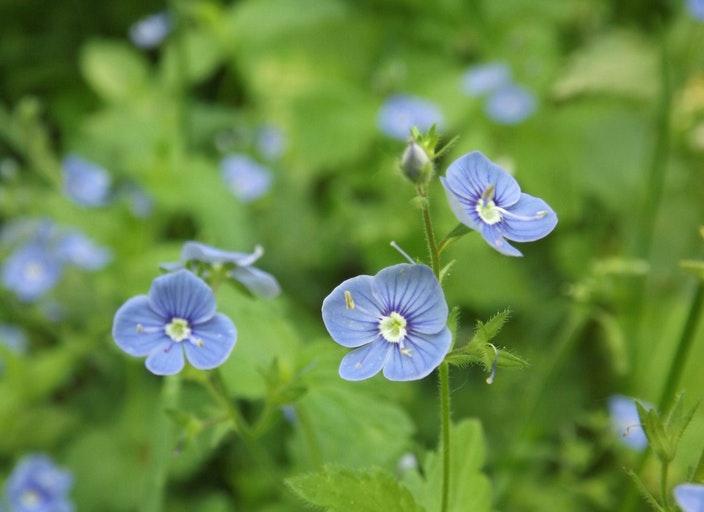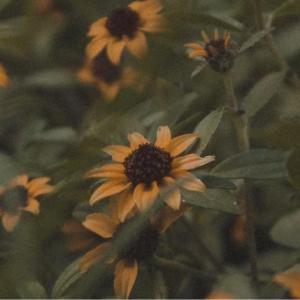
Spreading perennial creeping speedwell is a ground cover plant with delicate blooms. Veronica filiformis is a trailing perennial that grows to a maximum height of 5 inches and has tiny, solitary blooms. The blossoms, which have four circular petals in pink, purple, or blue hues, are produced throughout the spring and summer. In warm climates, the scalloped foliage is always present.
These plants proliferate swiftly, forming mats up to 30 inches across. Although useful for covering wide areas, this spreading propensity might cause them to expand outside of their designated growth zones. In certain places, the plant is regarded as an invasive weed.
Careful Creeping Speedwell
Creeping speedwell grows naturally on lawns, fields, and meadows and is relatively simple to maintain. It can withstand mowing and foot activity well and is fairly resilient. In actuality, mower-blown chopped bits readily take root and disseminate the plant farther. These plants are wonderful complements to footpaths or rock gardens.
Deer and rabbits are not attracted to creeping speedwell. If the soil is kept excessively damp, they are subject to root rot and other fungal issues. 2 Be aware that the thick mats the plants have produced may include parasites and fleas.
Light
It is possible to cultivate creeping speedwell in both full sun and shade. However, when growing in warm areas, full sun may be too harsh for creeping speedwell. Full shadow plants often do not blossom properly. Planting creeping speedwell in a somewhat shaded location is perfect for growth and bloom, especially in the afternoon.
Hardy soil creeping speedwell is a common sight in meadows, fields, and lawns. It can tolerate some clay but favors loamy, sandy, draining, and wet soil. Although they may thrive in slightly acidic and slightly alkaline soils, these plants thrive in soil that has a pH level that is neutral.
Water
Creeping speedwell is regarded as drought-tolerant after it has been established. Only water these plants after the top inch or two of the soil starts to dry up to prevent issues with damp soil. It is preferable to water speedwells more often when they are young and freshly planted until they get established. To maintain the health of established plants, 1 inch of water each week is sufficient.
Thermodynamics and Humidity
As long as it is planted in USDA hardiness zones 3 to 9, this groundcover plant can withstand a broad variety of temperatures and humidity levels. The plant will stay evergreen in warm areas, but not in regions where greater seasonal temperature variations are anticipated.
Fertilizer
Since creeping speedwell requires little water and may even thrive in unfavorable soil, frequent fertilizer is not required. However, if you want to make sure the plant gets the nutrients it needs, incorporate compost or a well-balanced fertilizer into the soil in the early spring.
Pruning
Although it may be desirable, pruning is not required to prevent the plant from spreading. To achieve this, just clip the plant using garden snips. A lawnmower is the greatest tool for efficiently completing the task of cutting down huge sections of creeping speedwell that are utilized as ground cover. However, it is recommended to use a collecting bag while mowing these plants if you don't want the trimmed parts to grow root.
Especially for plants cultivated in regions with harsh winters, stop trimming in the late summer. The plants may then produce enough mature leaves to provide protection during the winter. Late-season pruning will result in new growth that is too delicate to withstand the winter.
Speedwell that is spreading rapidly
Creeping speedwell spreads well, which makes it simple to grow more plants. Division, cutting, or layering may be used to achieve it.
For plants whose cores start to appear sparse or scraggly, division is a fantastic alternative. You will need a hand shovel, snips, gardening gloves, and a garden shovel to split the plant. then adhere to these guidelines:
Use a garden shovel to carefully dig around the plant in the early spring to dislodge the roots. Continue doing this up until the plant can be pulled out of the ground by its root system.
Remove the plant from the ground slowly.
Divide the plant into whichever many portions you want using the shovels and snips. Just make sure that the roots and leaves in each portion are strong. Throw away any empty spaces.
Place each part where you want it to be.
You'll need a tiny pot, wet, well-drained soil, and a sharp set of snips to take cuttings. then adhere to these guidelines:
Cut a stem below a leaf node using the snips. Trim a piece of about 6 inches in length.
Leaves on the bottom part of the cutting should be removed.
Bury the cut end in a damp patch of ground. As here is where roots will develop, be sure that multiple nodes are buried.
Keep the ground wet but not drenched. Till roots develop, place the cuttings in bright, indirect light.
By gently pulling on the cutting, you may check for roots. If there is opposition, roots have developed. When that occurs, harden the cutting off and relocate it to its final destination.
A hand shovel, a set of snips, and a pair of gardening gloves are required for layering. then adhere to these guidelines:
Locate a node on the stem where you want to spread the plant.
Place the node underneath. A few weeks should pass before roots emerge.
By gently pulling on the concealed node, you may check for roots. Resistance indicates the formation of roots. You may either leave the node in place at this stage or remove the stem that connects it to the rest of the plant, dig out the new root system, and plant it where you choose.
Creeping Speedwell Seed Growing Instructions
You may also start growing creeping speedwell from seeds, both inside and outdoors. Start the seeds eight to ten weeks before the last frost for indoor development. Small pots, strong indirect lighting, and a wet, permeable seed-starting mix, such a peat moss mix, are all necessary. then adhere to these guidelines:
The seed starting mix should be moistened before being added to the pots.
The small seeds should be lightly sprinkled and then gently pressed into the wet dough. Because they need light to grow, don't bury them.
Put the pots in a location with strong, indirect light.
Continually moisten the soil.
Harden off your seedlings as soon as the risk of frost has passed. After that, plant them in their appropriate garden locations.
Follow these guidelines to start seedlings outside:
Clear the area of weeds and work in organic material, such as compost, once the danger of frost has passed. Given that the seeds are tiny and susceptible to wind-blown movement, it is better to choose a location that is wind-sheltered.
Spread the seeds thinly across the ground and lightly tap them into the soil to help them take root. Because they need light to grow, don't bury them.
As the seeds grow and sprout, keep the soil wet. Reduce watering gradually after the plants are bigger and more established.
Reseeding and Potting sluggish speedwell
Growing creeping speedwell in a container is a simple approach to keep it under control. Make sure the container you choose has openings for free-flowing drainage since damp soil might lead to fungus issues. You will eventually need to split the plant or put creeping speedwell in a bigger pot since it will eventually spread out and fill the container. The container should next be turned on its side and tapped on all sides to release the roots at this point. When it is feasible, slide the plant out and either split it with a shovel or a pair of snips, or put it in a bigger pot with loamy, well-draining soil.
Overwintering
Creeping speedwell does not need additional care to survive the winter when it is planted in the proper growth zones. Just watch out for too much moisture in the soil, as this might cause issues that could ultimately result in the plant dying. You may wish to cover the plant with plastic to keep some of the water out if the winter is very rainy.
The Best Way to Make Creeping Speedwell Bloom
Small, four-petaled blooms in shades of blue, purple, and pink are produced by creeping speedwells. Their cores are often white. Instead of a spikey raceme covered with blooms, like other Veronica species, creeping speedwell develops one flower per stalk. Pollinators like bees and butterflies are still drawn to these small blossoms.
Creeping speedwells are hardy plants that need little assistance to blossom. Make careful to find a planting location that gets a few hours of sunshine each day to promote flowering. Ideal location would have early light and afternoon shade. More flowers will develop if you deadhead wasted flower blossoms.
Issues That Often Arise With Creeping Speedwell
The plant known as creeping speedwell is incredibly resilient and seldom causes issues. In fact, overgrowth issues are more likely to provide difficulties for the gardener. However, even very resilient plants sometimes run across issues. When the soil is either too wet or too dry, creeping speedwell plants have the most problems, which show themselves as withering, soggy, or yellowing leaves.
Wilting Plant Life
In warmer areas where the soil dries up fast, this is often seen. If so, attempt to place your crawling speedwell there where it will get afternoon shade. To make sure the plant gets adequate water, increase the quantity and frequency of watering.
Yellowing, wilting, and soggy foliage
This may indicate root rot and is an indication of over watering.
2 If so, water less often and only when the top inch or two of the soil feels dry. Dig up the plant and remove any affected roots and leaves if root rot is detected. Before replanting, amend the soil with a substance that drains well, such sand or compost.
文章
sososo赞了

还没有人评论,快来抢沙发!









